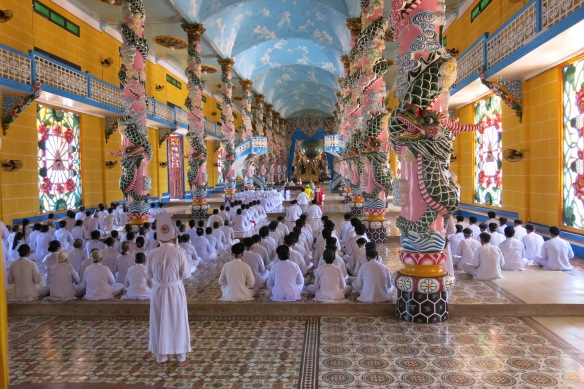
Vietnam is the birthplace of the unique and unlikely religion of Cao Dai. A mixture primarily of Buddhism, Taoism and Confucianism, Cao Dai also imports teachings of Muhammad, Jesus, and Laozi, among others, along with some Catholicism (they have a Pope and a Holy See) and a bit of spiritualism thrown in. The primary temple (Holy See) is in Tay Ninh, in the heart of the Mekong Delta in southwestern Vietnam. Above photo: Worshipers inside the Cao Dai Holy See Temple, Tay Ninh, Vietnam.
Suppressed by the Communists in 1975, Cao Dai was reprieved by the government in 1997 and has flourished since in this corner of Vietnam. Government estimates indicate at least 4.4 million declared worshipers, whereas the religion itself claims upwards of 6 million believers. Given Cao Dai’s long-time criticism of Communism — they also opposed French colonial rule and USA-backed President Diem — I’d guess these official numbers are an under-representation.
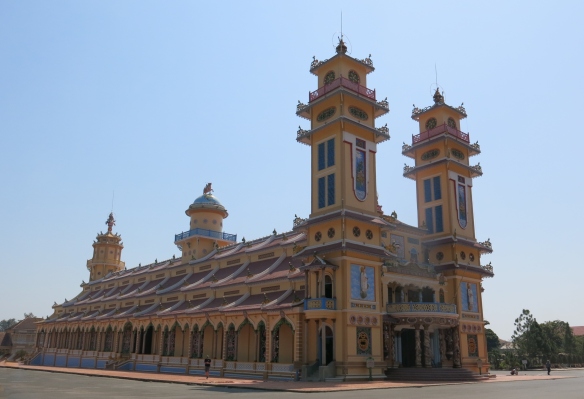
The Holy See Temple, Tay Ninh, 90 km northwest of Saigon.
Cao Dai believe in dual deities followed by a pantheon of saints and other holy figures. The ubiquitous, omnificent male Supreme Being, representing the yang, and the Holy Mother, representing the yin, create the balance of heaven and earth. Several historical persons are included in their panoply of revered souls, including, among others, Julius Caesar, Victor Hugo, Sun Yat-sen, and, inexplicably (in my opinion), Joan of Arc.
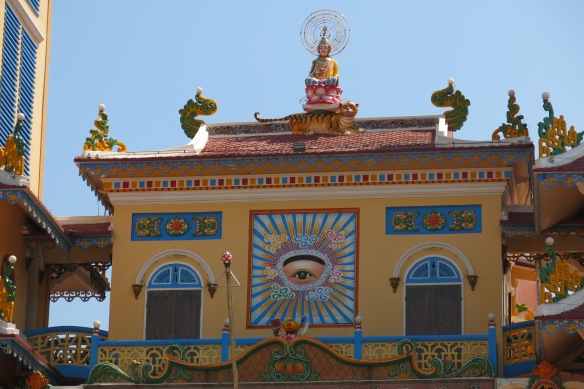
The Divine, All-Seeing Eye of God.
Cao Dai is rife with symbolism, the most important being the All Seeing Eye, also known as the Divine Eye. Represented as the left eye of God, this symbol is a reminder that God is omnipresent and sees all.
The Holy See is a spectacularly gaudy display of color and opulence. The decorations of the columns and windows are so colorful and elaborate they reminded me of the rococo stylism of 18th century Europe. The three colors of Cao Dai — yellow, red and blue — represent the the three religions from which form the belief systems of Cao Dai. Respectively, Buddhism, Confucianism, and Taoism.
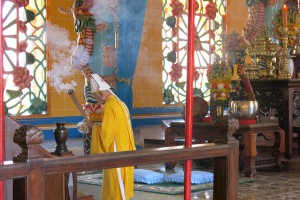
Worshipers inside the Cao Dai Holy See Temple, Tay Ninh, Vietnam.

Red represents Confucianism, and blue Taoism.
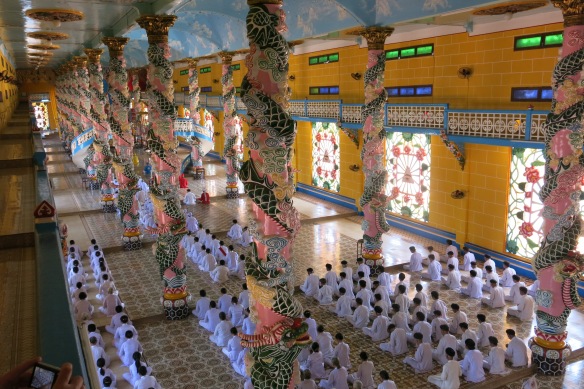
The Holy See during a service. Lay worshipers are dressed in impeccable white, and the three priests in yellow, blue and red (just left of center).
Cao Dai beliefs and principles fundamentally stress the “oneness” of each individual with God and the universe. There is the focus on perfecting oneself, but also strong values placed, in this order, upon the family, society, and mankind. As in many religions, Cao Dai professes a form of the Golden Rule. However, they take this precept of acting well and empathetically to another level, urging adherents to do good deeds to earn merit and a better position in the next life. Another principle that I found interesting was the emphasis on wealth and materialism.
Additional precepts in Cao Dai are also somewhat universal: do not kill, do not perform adultery, do not steal, do not get drunk, and do not sin by word (i.e. do not slander or be verbally abusive to others).
Cao Dai followers participate in four services per day at a temple with a fifth conducted at home. We were lucky enough to observe the service above from the balcony at the rear of the temple. Also in the balcony were about two dozen worshipers seated or standing around a circle of musicians.
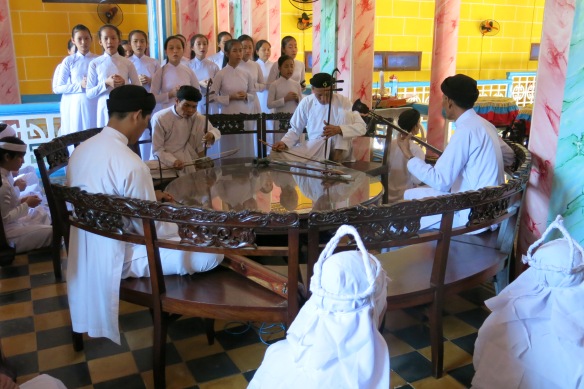
The cloth-covered wire headdresses of the two women in the right foreground indicate that they were in mourning for a loved one. The four men are playing traditional Vietnamese instruments, and the women in the left top corner formed a chorus of sorts, sometimes singing softly, other times chanting. Our guide explained that this small group of worshipers were conducting a separate “mourning” ceremony preceding the main service on the main level of the temple.
Each Cao Dai temple displays in its facility some rendition of the Divine Covenant of the Third Amnesty. The three figures represent three of the more important saints. From the left: revolutionary leader Sun Yat-sen, revered for rejecting oppressive rule in China; Victor Hugo, for his compassion and humanity; and Nguyen Binh Khiem, a 16th century Vietnamese leader, poet and teacher.
Visiting the Cao Dai Holy See was a bit of an overwhelming experience in that the gaudiness of the decor visually clashed with the plainness and simplicity of the worshipers. The theology, as well, struck me as overly complex and almost regulatory, yet the devotion of the Cao Dai worshipers was unquestionably yet quietly fervent. Certainly, the religion is complex in both belief systems and structure. This posting is but a small attempt to introduce a fascinating minor religion.
Some Interesting Facts:
- Cao Dai is considred a monotheistic religion with a Supreme Being or God, yet professes the male/female balance, or yin yang, by having dual male & female deities. Additionally, there is a pantheon of saints that are worshiped as well, among them:
- Joan of Arc
- Julius Caesar
- Moses
- Louis Pasteur
- Lenin
- William Shakespeare
- The Bodhisattva Quan Am (Guan Yin in Chinese)
- Kim Phuc, a 9 year old girl ran naked in terror and pain after surviving a napalm attack in 1972, and was raised in the Cao Dai faith. Her village of Trang Bang, was mistakenly identified by the South Vietnamese Air Force as a Viet Cong stronghold, then hit with napalm bombs. Some members of her family were killed in that attack. As a young woman, Kim was used by the communists as a propaganda symbol. She later sought asylum in Canada, where she continues to live. Kim started a foundation to provide medical and psychological help to child victims of war. She is also a UNESCO Goodwill Ambassador for the United Nations.
![]()

Carol Barbier Rolnick grew up in Japan and Southeast Asia, traveling extensively as a child through Asia, the Mideast and Europe on family vacations. Travel has continued as a priority through raising kids and continuing into retirement, extending adventures through the Americas, southern Africa, Asia, and repeat trips throughout Europe. Carol and her husband, Michael spent four summers based in Utrecht, The Netherlands, which has become like a second home. They are (still) aiming towards Australia-New Zealand and Antarctica to round off their continental travels.








